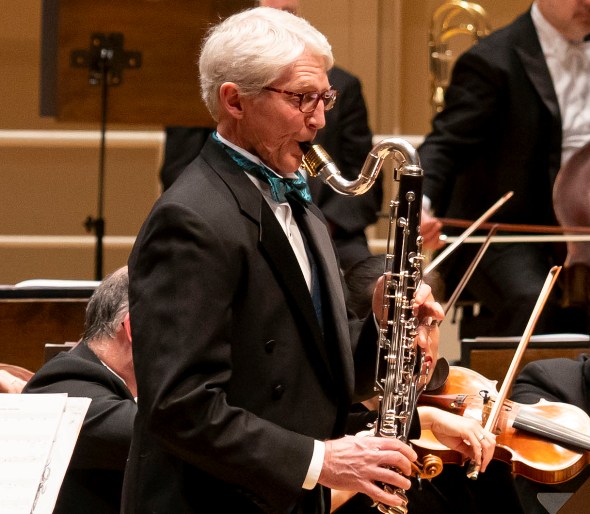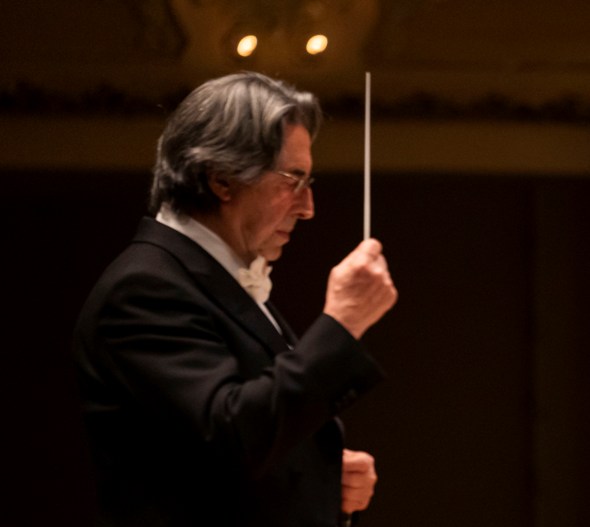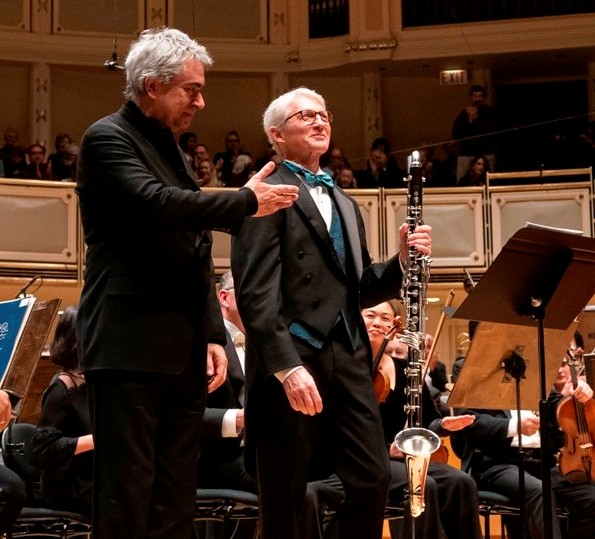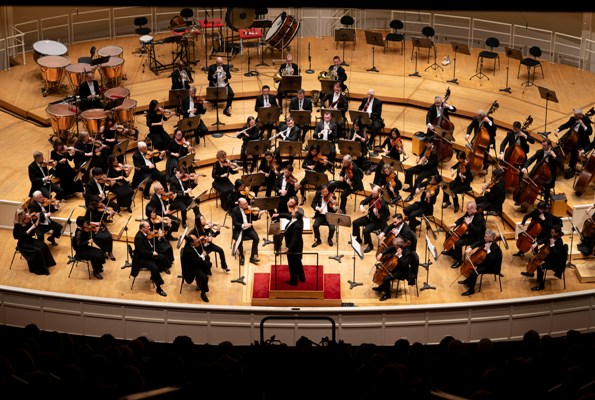At meeting of Beethoven and a bass clarinet, CSO summons sparks, Shakespearean tears

Chicago Symphony bass clarinetist J. Lawrie Bloom gave the world premiere of Nicolas Bacri’s “Ophelia’s Tears” at Orchestra Hall with Riccardo Muti conducting. (Photos by Todd Rosenberg)
Review: Chicago Symphony Orchestra conducted by Riccardo Muti; J. Lawrie Bloom, bass clarinet, in world premiere by Nicolas Bacri.
By Nancy Malitz
Two over-riding themes of music director Riccardo Muti’s current Chicago Symphony Orchestra season met in harmony in sold-out concerts Feb. 20-25 at Orchestra Hall – the conductor’s cycle through all nine Beethoven symphonies as part of the orchestra’s extensive Beethoven 250 celebration, and his desire to highlight the CSO’s key players with solo spotlights, often in world premiere concertos by composers the musicians helped to choose.
Thus Muti introduced the CSO’s highly regarded bass clarinetist J. Lawrie Bloom, his hefty instrument resting on a long spike in a new work called “Ophelia’s Tears” by French composer Nicolas Bacri, and generously framed the premiere with two Beethoven symphonies, including the Symphony No. 5 in C Minor, possibly the most famous symphony ever – ta-ta-ta-TA. The Fifth is associated with everything from the radio performance secretly marking onset of the D-Day invasion to historical events of more local importance like the first concert ever by the Chicago Symphony Orchestra in 1891, and its first concert in then brand new Orchestra Hall in 1904. In all, the program was an abundance of riches.
Muti opened with Symphony No. 2 in D major, in which the bold young Beethoven doffs his cap to his symphonic ancestors in the first movement, graciously winks in the second, and then, as if pedal-to-the metal, leaves the classical era receding in the rear-view mirror. (You can still check out this fascinating 1802 symphony, from an earlier CSO performance with Muti in 2019, on the CSO’s radio series
Bacri’s elegy for bass clarinet and orchestra, “Ophelia’s Tears,” opens with a menacing growl and then a solo melody from the extreme depths, rising ever slightly higher and falling back repeatedly on itself, as if trapped in an agitated dream-state.
One might expect a composer inspired by the tragedy of Shakespeare’s Ophelia, who suffers colossal collateral damage at Hamlet’s hand, to choose an instrument in the feminine register for portraying the young noblewoman’s spectacular unhinging. Indeed, Parisian composer Bacri’s first essay on the subject, “Ophelia’s Mad Scene” (2018), for soprano and clarinet, prowled after the high tradition of Donizetti’s Lucia, Thomas’ Ophelia, and Rimsky-Korsakov’s Marfa, albeit in a contemporary way. Bacri followed this with a second work, “Ophelia’s Solo,” for clarinet alone.
But it would take the CSO’s Bloom to make the 58-year-old composer serious about putting Ophelia and the bass clarinet together. Although Bacri had often declared the clarinet to be his favorite instrument since hearing Benny Goodman play Copland’s Clarinet Concerto on the radio as a boy, and despite having penned 30 works of one kind or another for clarinet since 1985, the composer confessed recently that he had never considered the bass clarinet “sexy enough” for a concerto.
Bloom traveled to Paris to show Bacri otherwise. When Muti offered the bass clarinetist a CSO concerto commission as part of the series designed to spotlight key players, Bloom – who has been with the orchestra since the Solti era – said he thought first of Bacri. (More details about this in the video below.) On his visit, he played Bacri’s own Ophelia music on the lower instrument to point out the possibilities, and almost before Bloom got back to Chicago, Bacri’s custom-made ideas for “Ophelia’s Tears: Concertante for Bass Clarinet and Orchestra” began to arrive.
Although it rises to frenzied heights, “Ophelia’s Tears” also indulges the bass clarinet’s particular ability to fathom almost bottomless depths of despair and then descend to nothingness. The intimacy of Bacri’s writing reflects his professed respect for the mournful potential of the instrument as well as the composer’s considerable orchestral command.
“Ophelia’s Tears” opens magisterially, with the orchestra seeming to hover closely in response to the bereft and often soaring solo line, a relationship of ceremonial dignity. But the alignment begins to crumble as the music makes a transition, without a break, into the middle movement, called “Madness.” Here Bacri’s fluctuations become more extreme, the mood sometimes violent, culminating in an extraordinary passage for Bloom’s bass clarinet, timbales, and percussion that is erratic to the point of hair-raising.
In fact, the soloist might have done even more with it. Up to this point in the Feb. 21 performance that I heard, the orchestra seemed tentative as well. But the picture soon sharpened as the music evolved into an eerie passacaglia for soloist and orchestra, almost a set piece in itself, which the composer describes in his notes as “feigned gaiety,” although the tragic through-line was apparent.
The final movement – “Death,” arrived at without break – also made a strong impression at first hearing. It begins with a solo cadenza that seems like the farewell of one already partially gone. Bloom’s delivery was winged with sadness. The disconsolate strings, which help usher the soloist’s ebbing lines to their close, provide the choral summing-up that is the equivalent of Queen Gertrude’s devastating remark how “one woe does tread upon another’s heel.”
The Bacri premiere was hardly the first CSO commission to focus on instruments of the orchestra’s bass register. Others during Muti’s tenure include James Stephenson’s Bass Trombone Concerto (introduced by CSO’s Charles Vernon) and Jennifer Higdon’s Low Brass Concerto (for two trombones, bass trombone and tuba). The latter was taken by the CSO to Carnegie Hall and soon thereafter performed by the co-commissioning Philadelphia Orchestra and Baltimore Symphony, with March performances upcoming in Nashville and Raleigh. Bass clarinetists in orchestras around the country will welcome “Ophelia’s Tears” as well.
As for Muti’s fleet, elegant, and often surprising Beethoven Fifth, the mood was electric and the ovation prolonged. If there is luck in this world, the Fifth Symphony also will show up on the CSO radio broadcasts. Muti’s choices of emphasis and detail in well-known works are notorious for sending one scurrying back to the the scores. But in dwelling on the effects of such finesse and detail in the orchestra’s superb performance, one risks leaving the impression that sheer power is lacking as a consequence. Not at all. This Fifth was astonishing. Not like a thunderbolt, but more like electricity in the veins. Muti has often described the CSO as akin to a Ferrari, which gets at the point. Everyone knows the power is there, will be there, instantly, as needed. And it was. But there was so much pleasure to be had while waiting for it..
A version of this review previously appeared on the website at Classical Voice North America.





I was in Russia on Beethoven’s music that performed by the Bolshoi Theater Chamber Orchestra conducted by Mikhail Tsinman, and the soloist is Alexander Kalashkov (violin). It was also great and when I was in my property in Berlin https://tranio.com/germany/berlin/ I travelled to Vienna to the Beethoven concert. I am so much in love with his talent.